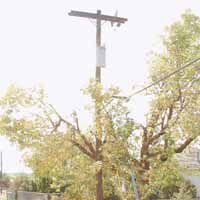| Trees sometimes look odd after they have been trimmed for line clearance, but they are done this way for the purpose of preserving their health. |
Every fall and spring, Utah Power and Light spends a great deal of money trimming trees and other vegetation away from it’s power lines. And each fall and spring someone gets unhappy with the way the trees on their property look after it is done.
“I understand that they need to trim the trees,” says Pete Howard of Carbonville. “But I don’t understand the way they have trimmed a tree on my property. They cut off some of the branches, but not others. They even left some cut up logs on my lawn.”
A visit to Howard’s house shows that the tree he is talking about does look odd. Standing in his tomato garden one can see branches trimmed off while others still seem to hang on power lines.
While UP&L doesn’t directly do the trimming themselves (they usually have subcontractors perform the duty) the work is done under their direction and their specific procedures. Over the years they have developed, along with professional arborists, the best ways to trim trees that are interfering with the lines.
Each year the company issues information on tree planting and trimming. They also put door hangers on homes and businesses in the areas where trimming is going on so that people will be aware they are in the area.
The trimming is done largely because of safety. Trees that grow too close to power lines create hazardous conditions and can also disrupt power service to a neighborhood or individual homes.
Clearance from the lines depends on the kind of tree that is growing there.
First, fast grow species of trees require at least 14 feet of clearance from power lines. Those trees include willows, Siberian and Chinese elms, cottonwood, box elder and paradise or heavenly trees.
Medium growth trees require at least 12 feet of clearance. These trees include Norway maple, pines and birch trees.
Slow growing trees need 10 feet of clearance from the lines. These species include spruce and oak.
Often trees that grow wild, a category that also seems to often include the fastest growing of trees, and measure less than six inches in diameter at four and a half feet high are removed by the company and treated with a herbicide. Trees are sometimes treated with tree growth regulators which slow down the process.
Any substantial firewood that is generated by the contractor doing the work is left on site for the resident to use or to give away.
The strange forms that are sometimes left when trees are trimmed has to do with what studies of trees have shown are the most healthy for them.
UP&L doesn’t let contractors to use “round over” trimming because it causes unnatural growth and actually wounds the tree and affects it’s overall health.
Often people try to trim trees around power lines themselves, but the company discourages this practice because of the danger to residents. The company asks that people do not do the following.
•Never climb trees near power lines and never climb a utility pole to trim a tree.
•When working outside with antennas, ladders or other long handled tools, always look up to see if a power line is in the way.
•Trim only trees that are not next to power lines. Never remove or trim branches that are directly on lines or near them.
Since the fall is also a time for people to plant trees, it is a good time for people to also know about where to plant and what kinds of plants to put in the ground. Some guidelines UP&L suggests includes the following points.
•Plant any trees that will ultimately reach 25 feet or more at least 25 feet away from overhead power lines.
•Trees that will mature below the power line level (a standard 25 feet) may be planted adjacent to overhead power lines.
•Trees and shrubs should be placed at least 10 feet away from any ground installations like transformers.
•Locate all underground utilities before digging holes to plant. UP&L suggests calling 1-888-221-7070 to get information on location services.
Crews will be working all fall on tree trimming and will need access to lines that run through private property areas.

